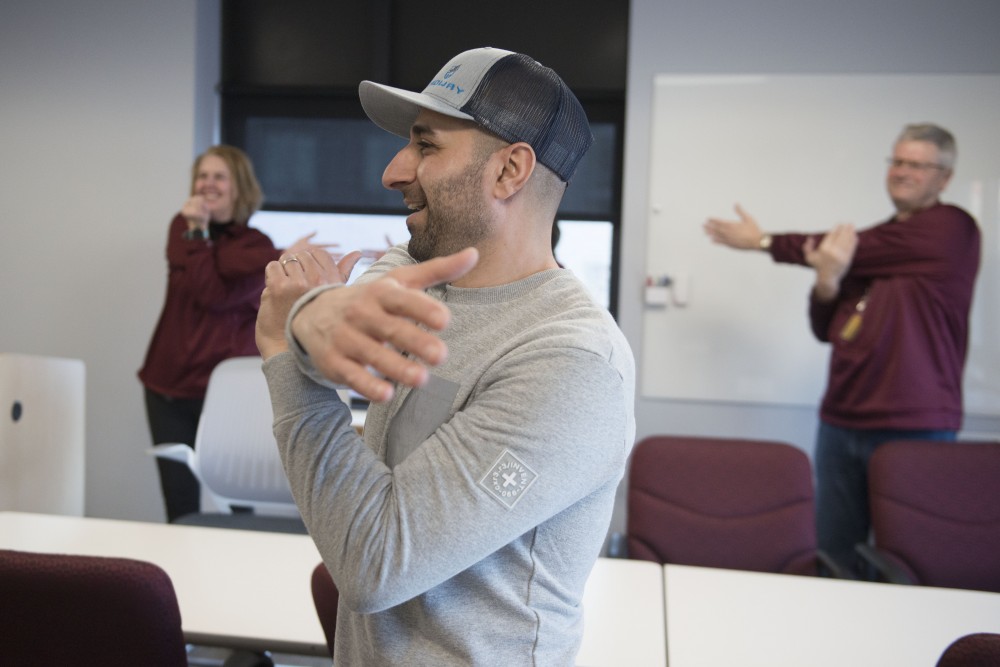While most of the campus is still asleep on weekday mornings, some University of Minnesota Facilities Management personnel gather as early as 5 a.m. to start their day with a dose of group exercise and camaraderie.
Graduate students from the College of Education and Human Development worked with the University to start a stretching program for physically taxing and repetitive positions on campus.
Because many workers in these demanding positions are over the age of 40 and are more prone to injury, stretching programs can prevent injuries and increase range of motion. So far, employees from the University’s Office of Human Resources and Facilities Management have participated in the program, which is looking to expand to other departments.
“It’s supposed to be a pre-shift warm-up and stretch,” said Nael Banat, a kinesiology graduate student and one of the two leaders of the program.
The employees perform different stretches depending on what kind of work they do. The 10-minute stretching programs often consist of neck, wrist, back, chest and hamstring stretches, among others. The stretches are tailored to help with different motions that are common in different positions.
Neal Binsfeld, a disability specialist for UReturn, a division of the Disability Resource Center that assists University employees return to work after injuries or other medical conditions, helped create and launch the program.
The program began in mid-November on the West Bank campus. Some sessions are now self-led by participants, often drawing up to 30 employees per meeting, said Kelly Richardson, a facilities team manager and facilitator of the program’s continuing West Bank stretching groups. Last month, the program started to hold sessions on the East Bank campus to be closer to where more employees worked.
“The benefit is not only the physical part of stretching, it is the kind of camaraderie that is the process. It is a team. The team is getting prepared for the day,” Binsfeld said.
Binsfeld said Banat and his co-leader, fellow graduate student Andrea Santi, have the right energy to make them fit leaders of the program.
“They believe in what they’re trying to do,” Binsfeld said. “They believe that exercise will benefit people’s lives.”
The employees who begin their shifts with the stretching program say the sessions have become an enjoyable part of their workday.
“I actually like it. It kind of wakes you up a little,” said Anita Fimon, a former M Dining cook who now works as a custodian in University Services. “It shakes the cobwebs.”
Fimon regularly attends the 5 a.m. session at Scott Hall. She said she considers the program a necessary step for the University to protect its employees from overuse and work-related injury.

Tim Ravn, a tradesman of 35 years, University electrician and one of the most lively members at the East Bank 7 a.m. session, said he was initially skeptical of the program’s benefits. But his opinion has changed in the weeks since the program was implemented for East Bank staff.
“The stretching program is beneficial, very beneficial,” he said. “We have fun, but we do our work.”
Program leaders Santi and Banat said they work to prepare members to be self-led in each session. They hope members will continue the program once they are gone.
“The goal for the future is for management and leaders in all these shifts to basically [stretch] every time before their shifts,” Banat said.
Looking to the future, Binsfeld said he hopes to see the program become a University-wide and even system-wide initiative. He said there has been interest recently from library workers and from staff at the St. Paul campus’ animal hospital.
“This is a start. The stretches are just a start,” Binsfeld said.

Correction: A previous version of this story misstated Anita Fimon’s previous title. She was an M Dining cook.








